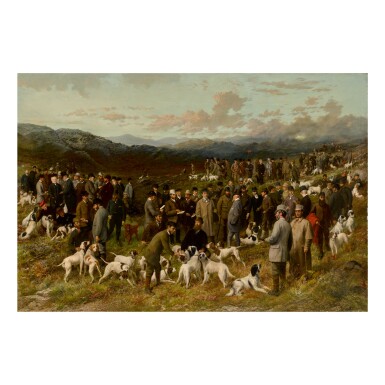19th Century European Art
19th Century European Art

Property from the Estate of Marcel Lindenbaum
GEORGE EARL | A FIELD TRIAL MEETING AT BALA, NORTH WALES, WITH PORTRAITS OF JUDGES, OWNERS, BREAKERS AND WINNING DOGS
Auction Closed
January 31, 04:23 PM GMT
Estimate
25,000 - 35,000 USD
Lot Details
Description
Property from the Estate of Marcel Lindenbaum
GEORGE EARL
British
1824 - 1908
A FIELD TRIAL MEETING AT BALA, NORTH WALES, WITH PORTRAITS OF JUDGES, OWNERS, BREAKERS AND WINNING DOGS
oil on canvas
52¼ by 77¾ in.
132.7 by 197.5 cm
Talbot Radcliffe, Presaddfed Estate, Anglesey, Wales (and sold, Christie's, New York, May 30, 1980, lot 299, illustrated)
Sale: Sotheby's, New York, June 8, 1990, lot 90, illustrated
Acquired at the above sale
William Secord, Dog Painting 1840-1940, A Social History of the Dog, Suffolk, England, p. 121-22, no. 50, illustrated
Established in 1873 amidst the growing popularity of dog shows in Britain, The Kennel Club sought to apply a standard of breeding rules and stud book registration already commonplace in the upper echelons of the equestrian world to dogs. George Earl, an early member of the club, aimed to bolster the canine community in a similar way to his predecessor George Stubbs, who, through his equine portraiture, had elevated horses from common animals to celebrity portrait sitters.
In the present work, Earl invents a trial meeting of pointers and setters, set at Bala, North Wales, as a composite stage to collect the famous faces of the day, celebrating the superiority of British gundogs. The earthy, atmospheric setting in the Welsh highlands is distinctly British, and each dog is of traditionally British breeding save for one, Plunkett, the Irish Setter. In the present work, a plaque along the bottom edge of the painting lists each dog’s name, placing a unique emphasis on the animals' identities. As an homage to his contributions as an early member of The Kennel Club, several works by Earl and his daughter Maud currently remain in the art gallery in their headquarters in London.
